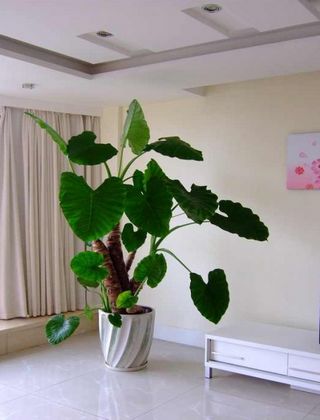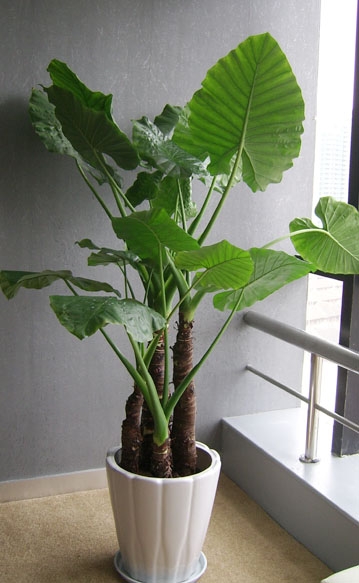Explain in detail the culture methods and matters needing attention of Dishui Guanyin.
Dishui Guanyin culture method:
1. Temperature: like warmth, growing rapidly when the temperature is more than 25 ℃, and the most suitable temperature for growth is 25ml / 30C. It has a certain ability to resist cold, and the overwintering temperature can be maintained above 2 ℃.
2. Light: like semi-overcast, can not bear the exposure of strong sunlight. From May to September, shade should be provided to cover about 50% of the sun. Then we should let Dishui Guanyin enjoy plenty of sunshine the rest of the time. Do not tolerate excessive shade, otherwise we will see that the petiole is likely to become thinner and longer, not only the plant shape is not beautiful, but also easy to break.

3. Watering: because the leaves are huge and consume a lot of water, they are afraid of drought. Like the slightly wet soil environment, during the growth period of watering to master "dry and wet and wet", we should pour enough water, even if a little more water does not matter. Need to pay special attention to the high temperature in the summer, we must pay more attention to water supply, to meet the water requirements of the plant. Because the leaf surface of dripping Guanyin is relatively large, the leaf tip of dripping Guanyin often spits water droplets in the morning, which becomes a strange phenomenon, so it is called "dripping Guanyin". The requirement of aquaculture dripping Guanyin is that we try to keep the basin soil moist at ordinary times to ensure that the plant can absorb enough water and use the root pressure of the plant to transport the water to the leaf tip and spit it out; when the basin soil is dry, there will be no water to drop. For the control of moisture in winter is also very important, slightly maintain the wet state of the basin soil, the leaves are not soft and sagging; the basin soil is too wet, it is easy to lead to rotten roots.
4, environmental humidity: like the humid environment, avoid dry air, the growing season is sunny and dry, should often spray water to the branches and leaves and around, in order to maintain high air relative humidity.
5. Fertilization; like to be fertilized. Because of the large growth, it is necessary to replenish nutrients in time to make the stem grow stout, the leaves large and bright green; when it lacks fertilizer, we will obviously see that its leaves become smaller and yellowish in color. Nitrogen-based fertilizer should be applied every 10 days during the growth period. People stop applying nitrogen fertilizer after autumn and topdressing 230: phosphorus and potassium fertilizer. Stop fertilizing in winter.

6. Pruning: yellow leaves should be cut off at any time. Because the petiole is long, it is necessary to avoid breaking the petiole when moving, placing and maintaining. If it is injured, it should be cut off in time.
7. Turn the basin: turn the basin once every 1 ~ 2 years. The requirement for soil is not high, but we like the sandy loam which is fertile, loose and well drained. We can use rotten leaf soil, garden soil, peat soil, river sand and other materials to prepare. If sufficient basal fertilizer is applied, the leaves can be enlarged. As the leaves of Dishui Guanyin are relatively large but the number is relatively small, and the petiole is long, try to avoid damage to the leaves when moving the plant and maintenance, otherwise it may reduce the ornamental value.
8. Reproduction: sowing, cutting, ramet, etc.
The main results are as follows: (1) sowing: wild plants often bear seeds and sow in spring. The suitable temperature for germination is 25-28 ℃, and germinates 20-25 days after sowing.
(2) insertion: it will be carried out in April. Cut the sturdy stem to grow about 10 cm, with
The stem segments of several bud eyes are used as cuttings, slightly dried and then obliquely inserted or lying flat on the seedbed, with the depth of the stem segment buried as the degree; the cuttings can also be directly planted in the basin. Keeping the substrate moist and ambient temperature 25~2TC after insertion, it can take root and survive after 4-5 weeks.
(3) ramet: potted plants are easy to produce many small plants in the base, which can be combined in April.
Turn the pot to split, separate the small plant from the mother plant and plant them respectively. Ramet should be carried out when the temperature reaches 20C or higher, and new buds can be produced in about 20 days on the basis of keeping the substrate moist.

Notes on dripping Guanyin:
1. Warm reminder: the white juice in the stem of dripping Guanyin is a poisonous liquid, and the dripping water is also poisonous. if you accidentally touch or eat its juice accidentally, it is likely to cause discomfort in the pharynx and mouth, and burning pain will be felt in the stomach. Therefore, people who breed Dishui Guanyin must be reminded to pay special attention, and should pay special attention to prevent young children from eating by mistake. But Dishui Guanyin is not a carcinogenic plant.
2. According to professional analysis, because dripping Guanyin is toxic, itching or strong irritation will occur when the skin touches its juice, and eye contact with juice can cause severe conjunctivitis and even blindness. If you eat stems and leaves by mistake, you will have symptoms of nausea and pain, and in serious cases, you will suffocate, resulting in heart paralysis and death. Therefore, exposure to Dishui Guanyin should be reduced as much as possible. Families with children had better not plant.
Related
- Wuhan Hospital Iron Tree Blooming Result Was Instantly Frightened by the Gardener Master
- Which variety of camellia is the most fragrant and best? Which one do you like best?
- What is the small blue coat, the breeding methods and matters needing attention of the succulent plant
- Dormancy time and maintenance management of succulent plants during dormancy
- Minas succulent how to raise, Minas succulent plant pictures
- What are the varieties of winter succulent plants
- How to raise succulent plants in twelve rolls? let's take a look at some experience of breeding twelve rolls.
- Attention should be paid to water control for succulent plants during dormant period (winter and summer)
- Watering experience of twelve rolls of succulent plants
- Techniques for fertilizing succulent plants. An article will let you know how to fertilize succulent plants.



